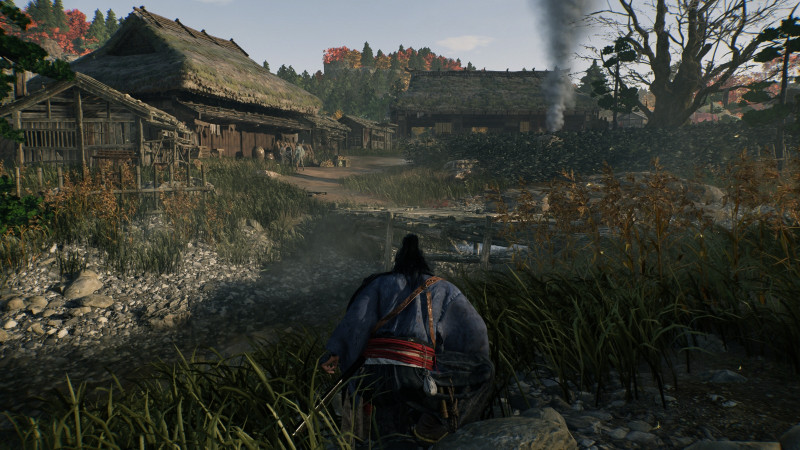A Rōnin is a samurai without a master. Unshackled from bonds, these wandering swordsmen are free to carve their own path, and that freedom forms the foundation of Rise of the Ronin. The adventure is Wo Long: Fallen Dynasty and Nioh developer Team Ninja’s first choice-driven, open-world action game. We recently got another peek at the title during The Game Awards, and we spoke to the game’s lead designers to get some insight and context as to what the adventure entails.
Set in 1863, Japan, players control a nameless Rōnin acting as a kind of work-for-hire warrior called a Veiled Edge. The game unfolds in the middle of what’s known as the “Bakumatsu” period. A decade prior, Japan’s centuries of isolation came to an end thanks to the arrival of the American “black ships” led by Commander Matthew C. Perry, kicking off the nation’s years-long transformation from its militaristic Tokugawa Shogunate government to the modernized empire brought about by the Meiji Restoration. Game director Fumihiko Yasuda tells us this collision of East and West and the resulting political and societal chaos was “the most exciting and eventful handful of years” of Japan’s history.
“Nioh was set in what’s called the Sengoku period, or which is sort of the Warring States period, where there were samurai who fought in the very traditional style,” says producer Yosuke Hayashi. “But we wanted this new Bakumatsu, which is sort of the end of the Edo era, …it’s a lot more modern, so we thought it allows for a unique setting when we were thinking about creating a fiction story inspired by a certain moment in time. It allowed for a very unique setting for us.”
Unlike the fantastical Nioh and Wo Long, Rise of the Rōnin shuns those supernatural elements in favor of telling a more grounded historical drama. Yasuda believes this is necessary for players to fully immerse themselves into the story and setting. Expect to encounter several real-life figures of the era, such as Sakamoto Ryōma and Yoshida Shōin. Though the narrative weaves in real-life events, it’s a fictional tale that players have the freedom to mold thanks to the inclusion of choices.
In another first for a Team Ninja action game, Rise of the Rōnin features decision-making that steers the adventure as players see fit. Conversations feature multiple responses, and key story moments present options such as choosing whether to kill or spare an assassination target.
Don’t expect a large number of these branches to present themselves during the main story, but completing certain side missions related to the main narrative or centering on an important character will help steer the overall adventure toward one of several endings. These include Bond Missions, which involve helping specific characters to improve your relationship with them.

Yasuda states the concept of bonds is a central theme of Rise of the Rōnin. “So you have a lot of characters that you meet throughout the story that you can develop bonds with,” Yasuda explains. “And a lot of side quests are also tied to these historical figures. And they’re also the system of forming bonds with lands and different locations. So, by helping out people in certain lands, you can deepen your bond with them. A lot of motivation for exploring the world is centered around these systems of bonds with characters and locations.”
The Rōnin himself symbolizes this freedom. Team Ninja describes him as a fully realized character with a fleshed-out backstory, but making decisions allows players to decide how he’s depicted in the story. The studio wouldn’t divulge much more into his personality or ultimate goal, but players will have plenty of time to get to know him while roaming Rise of the Rōnin’s freely explorable Japan.
Hayashi says Rise of the Rōnin’s open world presented a welcomed challenge for the studio traditionally known for creating linear levels or, at most, large hubs. “Something we’ve always wanted to sort of do was to create an open-world title,” says Hayashi. “I think that was sort of a natural next step for us.”
Humorously, Yasuda adds that Team Ninja is so accustomed to designing games where players kill anything that moves that crafting an experience with less expendable background characters, such as civilians, has been “impactful” and “a challenge.”

The game features three major cities of the era: Yokohama, Kyoto, and Edo (known today as Tokyo). Yasuda states that the countryside and rural areas between these cities are ravaged by bandits and other threats, along with copious side missions, but doesn’t reveal much more than that. In terms of transportation, trailers have shown players riding on horseback as well as deploying a bird-shaped glider to quickly soar across a city. Players also have a grappling hook used to quickly ascend vertical spaces and fly into the air, which can be used in tandem with the glider to commit aerial assassinations.
Yasuda describes Rise of the Rōnin’s close-quarters swordplay as having familiar elements to games like Nioh. The game includes different weapon styles, parrying appears to be an important skill, and players can employ tricks like setting their katana on fire to deal extra damage. However, Rōnin were known for using a variety of weapons, and that’s represented by polearms and the most devastating weapon granted by the time period: guns. The influx of Western firearms, such as pistols and rifles, adds a vital ranged element to the action. The grappling hook can also be used offensively; a recent trailer showed the Rōnin hooking it to an explosive barrel to swing and lob at a mob of targets. The story may be more reality-based, but the action is as over-the-top as you’d expect from a Team Ninja title.
Team Ninja states Rise of the Rōnin’s combat revolves around studying and learning enemy patterns gleaned after repeated failures, suggesting it will be as challenging as the games preceding it. When I asked if it still punishes death in the same Soulslike fashion, where players must retrieve fallen experience points, and how the more realistic story would justify this, Yasuda confirmed it does and involves a progression resource called Karma. It’s an apt name; the developers say the word symbolizes the destiny people carry from one life into the next. However, Yasuda clarifies that Karma only represents one system. There is another, more traditional type of XP that players retain after death. “You can look forward to the details of this in the future,” Yasuda says.
Rise of the Rōnin is an exciting challenge for Team Ninja. While the team is known for action first and foremost, it’s eager to spread its wings into the open-world genre and is committed to telling a story that feels authentic to the era it depicts. “We’re hoping that players can really feel like they’ve traveled to this important era in Japanese history and enjoy that experience,” says producer Yosuke Hayashi. We’re hoping for the same when the game arrives on March 22.
Source link
